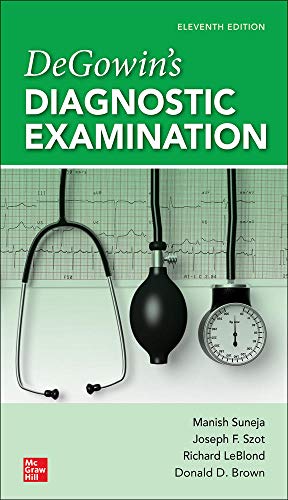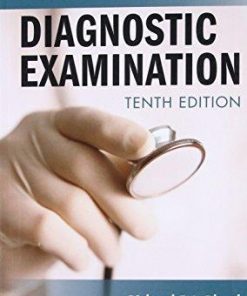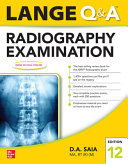(Ebook PDF) DeGowins Diagnostic Examination 11th Edition by Richard LeBlond, Donald Brown, Manish Suneja 1260134881 9781260134889 full chapters
$50.00 Original price was: $50.00.$25.00Current price is: $25.00.
DeGowin’s Diagnostic Examination 11th Edition by Richard F. LeBlond, Donald D. Brown, Manish Suneja – Ebook PDF Instant Download/DeliveryISBN: 1260134881, 9781260134889
Full dowload DeGowin’s Diagnostic Examination 11th Edition after payment.

Product details:
ISBN-10 : 1260134881
ISBN-13 : 9781260134889
Author: Richard F. LeBlond, Donald D. Brown, Manish Suneja
Publisher’s Note: Products purchased from Third Party sellers are not guaranteed by the publisher for quality, authenticity, or access to any online entitlements included with the product. The classic guide to the undifferentiated patient–enhanced by new cases Technological advances have taken testing and imaging to remarkable new places—yet establishing patient history and performing physical examinations are more important now than ever. This classic guide has been showing students and clinicians how to approach the diagnostic process thoughtfully and systematically for decades—and this revised edition brings you completely up to date. Part physical examination primer, part differential diagnosis tool, DeGowin’s Diagnostic Examination provides the information and insights you need to make accurate, evidence-based diagnostic hypotheses.
DeGowin’s Diagnostic Examination 11th Table of contents:
Part 1: The Diagnostic Framework
1. Diagnosis
1. Accurate Diagnosis Is Imperative
2. Diagnostic Process
3. Diseases and Syndromes
A. The Diagnostic Process
1. Stories
2. Gathering and Processing Information
3. Differential Diagnosis
4. Anatomic and Pathophysiologic Diagnostic Hypotheses
5. Cognitive Tests of Diagnostic Hypotheses
6. Selecting Diagnostic Tests
7. Rare Diseases
8. Certainty and Diagnosis
9. Prognostic Uncertainty
10. Summary of the Diagnostic Process
11. Caveat
12. An Example of the Diagnostic Process
2. History Taking and The Medical Record
A. Outline of the Medical Record
1. Scope of the History
2. How to Take a History
3. Do Not Make Assumptions
B. Completion of the Medical Record
1. Identification
2. The Informant
3. Chief Complaints
4. Past Medical and Surgical History
5. Family History
6. Social History
7. Military History
8. Review of Systems
9. Gynecologic History
10. Male History
11. Venereal Disease History
12. Medications
13. Allergies and Medication Intolerances
14. Preventive Care Services
15. Advance Directives
16. Physical Examination
17. Laboratory
18. Assessment
19. The Plan
C. The Oral Presentation
D. Other Clinical Notes
1. Inpatient Progress Notes
2. Discharge Summary
3. Clinic Notes
3. Physical Examination
A. Methods for Physical Examination
1. Inspection
2. Palpation
3. Percussion
4. Auscultation
B. The Screening Physical Examination
1. Preparing the Screening Examination
2. Performing the Screening Examination
C. Ultrasound in Bedside Diagnosis
1. Technical Considerations
2. Scope of Ultrasound in Diagnostic Examination
Part 2: The Diagnostic Examination
The Diagnostic Examination: Chapters 4 to 15
4. Vital Signs, Anthropometric Data, and Pain
A. Vital Signs
1. Body Temperature
2. The Pulse: Rate, Volume, and Rhythm
3. Respiratory Rate and Pattern
4. Blood Pressure (BP) and Pulse Pressure
B. Anthropometric Data
1. Height
2. Weight
C. Pain
1. Diagnostic Attributes of Pain, PQRST
2. Pain Syndromes
D. Clinical Vignettes and Questions
5. Nonregional Systems and Diseases
A. Constitutional Symptoms
1. Fatigue
2. Appetite Disturbance
3. Thirst Disturbance
4. Constitutional Syndromes and Diseases
B. The Immune System
1. Common Immunodeficiency Syndromes
C. The Lymphatic System
1. Lymph Node Examination
2. Diseases and Syndromes of Lymphocytes, Lymph Nodes, and Plasma Cells
3. B-cell and plasma cell disorders
4. Diseases and Syndromes of Specific RegionalLymph Nodes
D. The Hematopoietic System and Hemostasis
1. Red Blood Cell (RBC, Erythrocyte) Disorders
2. Neutrophil Disorders
3. Myeloproliferative Disorders and Acute Leukemia
4. Platelet Disorders
5. Coagulation Disorders
E. The Endocrine System
1. Diabetes and Hypoglycemia
2. Disorders of Thyroid Function
3. Adrenal Disorders
4. Disorders of Parathyroid Function
5. Disorders of Pituitary Function
F. Clinical Vignettes and Questions
6. The Skin and Nails
A. Physiology of the Skin and Nails
B. Functional Anatomy of the Skin and Nails
1. Skin Layers
2. Skin Associated Structures
C. Examining the Skin and Nails
1. Evaluating Skin Turgor and Elasticity
2. Examining Nailfold Capillaries
D. Supplemental Aids to Dermatologic Diagnosis
1. Magnification
2. Diascopy
3. KOH Preparation
4. Tzanck Smear
5. Wood Light
6. Skin Biopsy
E. Skin and Nail Symptoms
1. Itching (Pruritus)
F. Skin and Nail Signs
1. Distribution of Lesions
2. Pattern of Lesions
3. Morphology of Individual Lesions
4. Generalized Skin Signs
5. Changes in Skin Color
6. Hair Changes
7. Fingernail Signs
8. Foot and Toenail Signs
9. Vascular Signs
10. Signs of Systemic Lipid Disorders
G. Skin and Nail Syndromes
1. Common Skin Disorders
2. Skin Infections and Infestations
3. Bullous Skin Diseases
4. Skin Manifestations of Systemic Diseases
5. Vascular Disorders
6. Skin Neoplasms
H. Clinical Vignettes and Questions
7. The Head and Neck
A. Major Systems of the Head and Neck
B. Functional Anatomy of the Head and Neck
1. The Scalp and Skull
2. The Face and Neck
3. The Ear
4. The Eyes
5. The Nose
6. Mouth and Oral Cavity
7. Larynx
8. The Salivary Glands
9. The Thyroid Gland
C. Physical Examination of the Head and Neck
1. Examining the Scalp, Face, and Skull
2. Examining the Ears, Hearing, and Labyrinth Function
3. Examining the Eyes, Visual Fields, and Visual Acuity
4. Examining the Nose and Sinuses
5. Examining the Lips, Mouth, Teeth, Tongue, and Pharynx
6. Examining the Temporomandibular Joint
7. Examining the Larynx
8. Examining the Salivary Glands
9. Examining the Neck
10. Examining the Lymph Nodes
11. Examining the Vascular System
D. Head and Neck Symptoms
1. General Symptom
2. Skull, Scalp, and Face Symptoms
3. Ear Symptoms
4. Eye Symptoms
5. Nose Symptoms
6. Lip, Mouth, Tongue, Teeth, and Pharynx Symptoms
7. Larynx Symptoms
8. Salivary Gland Symptoms
9. Neck Symptoms
E. Head and Neck Signs
1. Scalp, Face, Skull, and Jaw Signs
2. External Ear Signs
3. External Acoustic Meatus Signs
4. TM Signs
5. Hearing Signs
6. Eye Lid Signs
7. Eye Movement Signs
8. Conjunctiva Signs
9. Cornea Signs
10. Sclera Signs
11. Pupil Signs
12. Lens Signs
13. Retina Signs
14. Nose and Sinus Signs
15. Breath Signs
16. Lip Signs
17. Oral Mucosa and Palate Signs
18. Teeth and Gum Signs
19. Tongue Signs
20. Pharynx Signs
21. Larynx and Trachea Signs
22. Salivary Gland Signs
23. Neck Signs
24. Midline Cervical Mass
25. Lateral Cervical Masses
26. Thyroid Signs
F. Head and Neck Syndromes
1. Squamous Cell Cancers of the Head and Neck
2. Scalp, Face, Skull, and Jaw Syndromes
3. Eye Syndromes
4. Ear Syndromes
5. Nose and Sinus Syndromes
6. Oral Syndromes (Lips, Mouth, Tongue, Teeth, and Pharynx)
7. Larynx Syndromes
8. Salivary Gland Syndromes
9. Thyroid Syndromes
10. Thyroid Goiters and Nodules
G. Clinical Vignettes and Questions
8. The Chest: Chest Wall, Pulmonary, and Cardiovascular Systems; The Breasts
Section 1: Chest Wall, Pulmonary, and Cardiovascular Systems
A. Major Systems and Physiology
1. The Thoracic Wall
2. The Respiratory System
3. The Lungs and Pleura
4. The Cardiovascular System
B. Superficial Thoracic Anatomy
1. The Chest Wall
2. The Lungs and Pleura
3. The Heart and Precordium
C. Physical Exam of The Chest and Major Vessels
1. Inspection of the Rib Cage and Thoracic Musculature
2. Palpating the Rib Cage and Thoracic Musculature
3. Examining the Lungs and Pleura
4. Examining the Heart and Precordium
5. Examining the Blood Vessels
6. Examining the Arterial Circulation in the Extremities
7. Examining Large Limb Veins
D. Chest, Cardiovascular, and Respiratory Symptoms
1. General Symptoms
2. Chest Wall Symptoms
3. Lung and Pleura Symptoms
4. Cardiovascular Symptoms
E. Chest, Trachea, and Respiratory Signs
1. Chest Wall Signs
2. Trachea Signs
3. Lung, Pleura, and Respiratory Signs
4. Vibratory Palpation
5. Sonorous Percussion
6. Auscultating Breath Sounds
7. Auscultating Voice Sounds
8. Auscultating Abnormal Sounds
9. Interpretating Pulmonary and Pleural Signs
10. Sputum Signs
F. Cardiovascular Signs
1. Inspection
2. Palpation
3. Percussion
4. Auscultating Heart Sounds
5. Auscultating Extracardiac Sounds
6. Auscultating Heart Murmurs
7. Systolic Murmurs
8. Diastolic Murmurs
9. Continuous Murmurs
10. Vascular Signs of Cardiac Activity
11. Arterial Circulation Signs
G. Chest, Cardiovascular, and Respiratory Syndromes
1. Chest Wall Syndromes
2. Respiratory Syndromes
3. Cardiovascular Syndromes
4. Other Cardiovascular Syndromes
5. Valvular Heart Disease
6. Congenital Heart Disease
7. Mediastinal Tumors
8. Pericardial Syndromes
9. Disorders of the Arterial and Venous Circulations.
10. Circulatory Disorders in the Head, Neck, and Trunk
11. Disorders of Large Limb Arteries
12. Disorders of the Major Extremity Veins
Section 2: The Breasts
H. Breast Physiology
1. The Female Breast
2. The Male Breast
I. Superficial Breasts Anatomy
J. Physical Exam of the Breasts
1. Breast Examination
K. Breast Symptoms
1. Breast Pain
L. Breast Signs
1. Breast Mass
2. Breast Tenderness (Mastodynia)
3. Breast Cysts
4. Supernumerary Nipples (Polythelia) and Breasts (Polymastia)
5. Inverted Nipples
6. Nipple Fissures
7. Duct Fistula
8. Skin or Nipple Retraction
9. Nipple Discharge
10. Nipple Scaling and Excoriation—Paget Disease
11. Areolar Gland Abscess
M. Breast Syndromes
1. The Female Breast
2. The Male Breast
N. Clinical Vignettes and Questions
9. The Abdomen, Perineum, Anus, and Rectosigmoid
A. Major Systems and Their Physiology
1. Alimentary System
2. Hepatobiliary and Pancreatic System
3. Spleen and Lymphatics
4. Kidneys, Ureters, and Bladder
B. Superficial Anatomy of the Abdomen and Perineum
1. The Abdomen
2. The Anus
3. The Rectum
4. The Sigmoid and Descending Colon
C. Physical Exam of the Abdomen
1. Inspection
2. Auscultation
3. Percussion
4. Palpation
5. Examining the Perineum, Anus, Rectum, and Distal Colon
6. Examining the Rectum
7. Examining the Sigmoid Colon
D. Abdominal, Perineal, and Anorectal Symptoms
1. Nonspecific Symptoms
2. Site-Attributable Symptoms
3. Esophagus, Stomach, and Duodenum Symptoms
4. Small Intestine and Colon Symptoms
5. Pelvic Symptoms
E. Abdominal Signs
1. Inspection
2. Auscultation
3. Percussion
4. Palpation
F. Perineal, Anal, and Rectal Signs
1. Inspection
2. Palpation
G. Abdominal, Perineal, and Anorectal Syndromes
1. Hepatobiliary and Pancreatic Syndromes
2. Acute Abdominal Pain Syndromes
3. Acute Abdominal Pain
4. Acute Epigastric Pain
5. Acute RUQ Pain
6. Acute LUQ Pain
7. Acute RLQ Pain
8. Acute LLQ Pain
9. Acute Suprapubic Pain
10. Subacute Abdominal Pain Syndromes
11. Chronic and Recurrent Abdominal Pain
12. Bloating and Distention Syndromes
13. Diarrhea Syndromes
14. Constipation Syndromes
15. Bowel Obstruction Syndromes
16. Abdominal Masses
17. Abdominal, Inguinal, and Other Hernias
18. Perineal, Anal, and Rectal Syndromes
19. Occult GI Blood Loss
H. Clinical Vignettes and Questions
10. The Urinary System
A. Overview and Physiology of the Urinary System
B. Urinary System Anatomy
C. Examining the Urinary System
D. Urinary System Symptoms
E. Urinary System Signs
F. Urethral Signs
G. Urinary System Syndromes
1. Hematuria
H. Clinical Vignettes and Questions
11. The Female Genitalia and Reproductive System
A. Overview of Female Reproductive Physiology
B. Anatomy of the Female Genitalia and Reproductive System
1. The Vulva
2. The Vagina, Uterus, and Adnexa
C. Examing the Female Genitalia and Reproductive System
1. The Female Pelvic Examination
D. Female Genital and Reproductive Symptoms
1. General Symptoms
2. Vulvar and Vaginal Symptoms
E. Female Genital and Reproductive Signs
1. Vulvar Signs
2. Urethral Meatus Abnormalities
3. Vagina Signs
4. Cervix Signs
5. Uterine Signs
6. Adnexal Signs
7. Rectal Signs
F. Female Genital and Reproductive Syndromes
1. Menstrual Disorders
2. Ovary Disorders
3. Uterine Disorders
G. Clinical Vignettes and Questions
12. The Male Genitalia and Reproductive System
A. Overview of Male Reproductive Physiology
B. Male Reproductive System Anatomy
1. The Penis
2. The Scrotum
3. Testis, Epididymis, Vas Deferens, and Spermatic Cord
4. The Prostate and Seminal Vesicles
C. Examining the Male Genitalia and Reproductive System
1. Examining the Penis
2. Examining the Scrotum
3. Examining Scrotal Contents
4. Examining for Scrotal Hernia
5. Examining the Testes
6. Examining the Epididymis
7. Examining the Spermatic Cord
8. Examining the Male Inguinal Region for Hernia
9. Male Rectal Exam
D. Male Genital and Reproductive Symptoms
E. Male Genital and Reproductive Signs
1. Penis Signs
2. Urethral Signs
3. Scrotum Signs
4. Testis, Epididymis, and Other Intrascrotal Signs
5. Prostate and Seminal Vesicle Signs
F. Male Genital and Reproductive Syndromes
G. Clinical Vignettes and Questions
13. The Spine, Pelvis, and Extremities
A. Major Systems and Their Physiology
1. Bones
2. Joints
3. Muscles, Tendons, and Bursae
B. Superficial Anatomy of the Spine and Extremities
1. The Axial Skeleton—Spine and Pelvis
2. Appendicular Skeleton
C. Examining the Spine and Extremities
1. Examining the Spine
2. Examining the Appendicular Skeleton
3. Brief Examination for Skeletal Injuries
D. Musculoskeletal and Soft Tissue Symptoms
1. Pain
E. Musculoskeletal and Soft Tissue Signs
1. General Signs
2. Thoracolumbar Spine and Pelvis Signs
3. Appendicular Skeleton, Joint, Ligament, Tendon, and Soft-Tissue Signs
F. Musculoskeletal and Soft Tissue Syndromes
1. General Syndromes
2. Syndromes Primarily Affecting Joints
3. Conditions Primarily Affecting Bone
4. Neck, Spine, and Pelvis Syndromes
5. Upper Extremity Syndromes
6. Conditions of the Entire Upper Limb
7. Lower Extremity Syndromes
8. Muscle Syndromes
G. Musculoskeletal Trauma Syndromes
1. Traumatic Neck Pain
2. Traumatic Back Pain
3. Traumatic Wrist, Arm, and Shoulder Pain
4. Traumatic Hip Pain
5. Traumatic Knee Pain
6. Traumatic Calf Pain
7. Traumatic Anterior Leg Pain
8. Traumatic Ankle Pain
9. Traumatic Heel Pain
H. Clinical Vignettes and Questions
14. The Nervous System
A. Overview of the Nervous System
1. Anatomic Organization of the Nervous System
2. The Peripheral Nervous System
3. Functional Organization of the Nervous System
B. The Neurologic Examination
1. Mental Status Screening Examination
2. Cranial Nerve (CN) Exam
3. Motor Examination
4. Examining Reflexes
5. Posture, Balance, and Coordination—The Cerebellar Exam
6. Sensory Examination
7. Testing Higher Integrative Functions
8. Testing Specific Peripheral Nerves
9. Specific Muscle and Nerve Movements
C. Neurologic Symptoms
1. General Symptoms
2. Cranial Nerve Symptoms
3. Motor Symptoms
4. Posture, Balance, and Coordination Symptoms
5. Sensory Symptoms
D. Neurologic Signs
1. Cranial Nerve Signs
2. Motor Signs
3. Reflex Signs
E. Posture, Balance, and Coordination Signs
1. Cerebellar Signs
2. Gait Disorders
3. Movement Disorders
4. Sensory Signs
5. Autonomic Nervous System Signs
6. Some Peripheral Nerve Signs
F. Neurologic Syndromes
1. Recurrent Headache Syndromes
2. Intracranial Traction, Displacement, and Inflammation Causing Headache
3. Intracranial Bleeding Headaches
4. Other Headaches
5. Seizures
6. Transiently Impaired Consciousness
7. Persistently Impaired Consciousness
8. Ischemic Cerebrovascular Disease
9. Degenerative and Autoimmune CNS Diseases
10. CNS Infections
11. Spinal Cord Disorders
12. Peripheral Neuropathies
13. Other Motor and Sensory Syndromes
14. Disorders of Language and Speech
15. Delirium
16. Impaired Cognition Syndromes
17. Other Syndromes
G. Clinical Vignettes and Questions
15. The Mental Status, Psychiatric, and Social Evaluations
Section 1: The Mental Status and Psychiatric Evaluation
A. The Mental Status Evaluation
1. Level of Consciousness (LOC)
2. Orientation
3. Attention
4. Memory
5. Thought
6. Perception
7. Intellect
8. Mood
9. Affect
10. Appearance and Behavior
B. Psychiatric Symptoms and Signs
1. Abnormal Perception
2. Parasomnias
3. Abnormal Affect and Mood
4. Abnormal Thinking
5. Abnormal Memory
6. Abnormal Behaviors
C. Psychiatric Syndromes
1. Multiaxial Assessment
2. Acute and Subacute Confusion
3. Anxiety Disorders
4. Mood Disorders
5. Personality Disorders and Abnormal Behaviors
6. Eating Disorders
7. Alcohol-Related Illness
8. Impulse Control Disorders
9. Adjustment Disorders
10. Grieving
11. Thought Disorders
12. Other Disorders
Section 2: The Social Evaluation
1. Evaluating Social Function and Risk
A. Common Social Syndromes and Problems
1. Common Social Syndromes and Problems
B. Clinical Vignettes and Questions
Part 3: Preoperative Evaluation
16. The Preoperative Evaluation
A. Introduction to Preoperative Screening
B. The History
1. Assessing Cardiovascular and Pulmonary Risk from History
2. Assessing Bleeding Risk from History
3. Assessing Metabolic Risk—Diabetes, Renal, and Hepatic Insufficiency
4. Age
5. Family History
6. Medications
7. Social History
8. Mechanical and Positioning Risks
C. The Physical Exam
D. Laboratory Testing
E. Summative Risk Assessment
F. Clinical Vignettes and Questions
Part 4: Use of the Laboratory and Diagnostic Imaging
17. Principles of Diagnostic Testing
A. Principles of Laboratory Testing
1. Principles of Testing for Disease
2. Selecting and Interpreting Tests
B. Examples
1. Comment
2. 2 × 2 Tables Revisited: Caveat Emptor
3. Rule-In; Rule-Out
4. Summary
C. Principles of Diagnostic Imaging
18. Common Laboratory Tests
A. Blood Chemistries
1. Albumin
2. Alkaline Phosphatase, Serum
3. Anion Gap, Serum
4. Alanine Aminotransferase (ALT), Serum
5. Aspartate Aminotransferase (AST), Serum
6. Bicarbonate, Total Serum (HCO3-), CO2 Content
7. Bilirubin, Total Serum
8. Blood Urea Nitrogen (BUN)
9. B-Type Natriuretic Peptide
10. Chloride, Serum (Cl-)
11. Cholesterol, Serum
12. C-Reactive Protein (CRP)
13. Creatine Kinase (CK), Serum
14. Creatinine, Serum
15. Creatinine Clearance
16. Ferritin, Serum
17. Glomerular Filtration Rate (GFR)
18. Glucose, Serum
19. Hemoglobin A1C, Glycohemoglobin
20. Iron, Serum (Fe2+)
21. Iron-Binding Capacity, Serum Total
22. Lactate Dehydrogenase (LDH), Serum
23. Phosphate, Serum Inorganic
24. Potassium, Serum (K+)
25. Protein, Total Serum
26. Protein: Albumin, Serum
27. Protein: Globulins, Serum
28. Protein: α1-Globulins
29. Protein: α2-Globulins
30. Protein: β-Globulins
31. Protein: γ-Globulins
32. Protein: Immunoglobulin IgG
33. Protein: Immunoglobulin IgA
34. Protein: Immunoglobulin IgM
35. Protein: Immunoglobulin IgD
36. Protein: Immunoglobulin IgE
37. Protein: Monoclonal γ-Globulins
38. Sodium, Serum (Na+)
39. Triglycerides
40. Urea Nitrogen
41. Uric Acid, Serum
B. Hematologic Data
1. Blood Cells
2. Erythrocyte Measurements
3. Leukocytes (WBC)
4. Coagulation
C. Urinalysis
1. Color
2. Acidity
3. Specific Gravity
4. Protein
5. Glucose
6. Ketones
7. Urine Sediment
8. Casts
D. Cerebrospinal Fluid (CSF)
1. Increased CSF Protein
2. Decreased CSF Protein
3. Elevated CSF Glucose
4. Decreased CSF Glucose
5. Cell Count and Differential
6. Increased CSF Leukocytes
E. Serous Body Fluids
1. Transudates
2. Exudates
3. Pleural Effusion
4. Peritoneal Effusion, Ascites
5. Serum/Ascites Albumin Gradient
6. WBC Counts
People also search for DeGowin’s Diagnostic Examination 11th:
diagnostic centre test list
characteristics of diagnostic test
diagnostic centre near me for blood test
degowin’s diagnostic examination
degowin’s diagnostic examination 11th edition
You may also like…
Business & Economics - Accounting
Mathematics - Algebra
Business & Economics - Sales & Marketing
Mathematics - Geometry and Topology
Business & Economics - Accounting
Chemistry - Chemistry - General & Miscellaneous
Business & Economics - Economics
Macroeconomics for Today 11th Edition by Irvin Tucker 9798214347974












